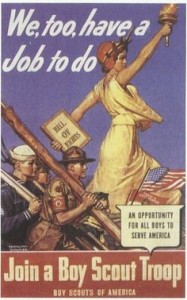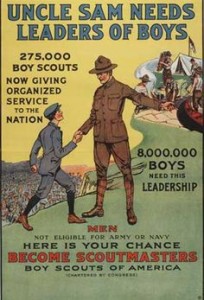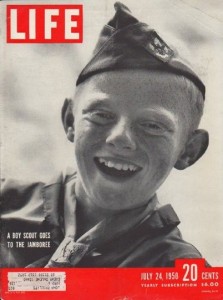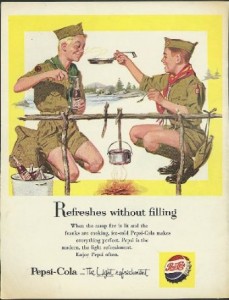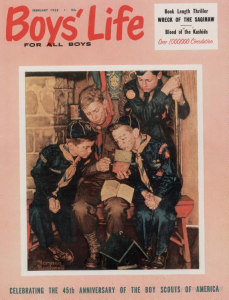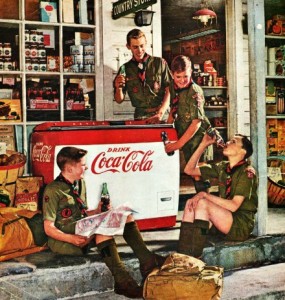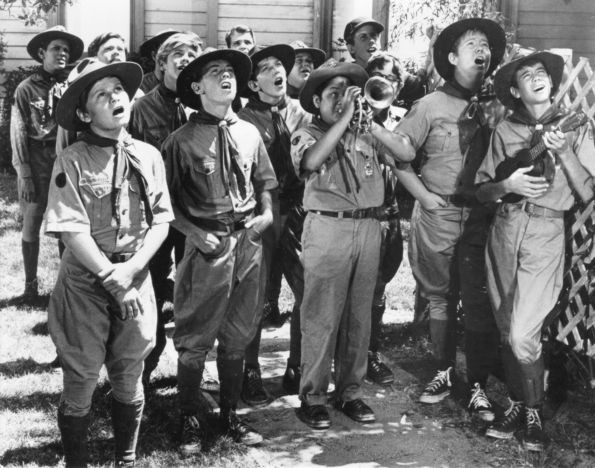
Scouting Pop Culture from the 40s to 60s That Will Take You Back
We heard how well you know Scouting in pop culture, you heard about Scouting references in the early 20th century, and now, Scouting Wire is uncovering Scouting in pop culture from 1940 to 1969. You might even say these decades were the Scouting ‘golden years’ as far as pop culture features go. Check out the slew of Scouting mentions in television, movies, advertisements, and art below, and you might be singing a different tune (like the song “Be Prepared” in the 1959 film featured below).
Scouts Featured in the 1940s
As World War waged on during the 1940s, Boy Scouts jumped to serve in war relief efforts. Collecting more than 300,000 tons of paper and 10.5 million tons of scrap metal, the Scouts played an essential role in assisting with the packaging, equipment and recycling needs of that time. Not only were the Scouts helpful, familiar faces in the eyes of the American public, Scouts were also featured in war-time posters as shown below.
Cinematically the 1940 film, “I Love You Again” kicked of the war-time decade with a movie featuring William Powell as a ‘Boy Ranger’ leader and the lovable Carl “Alfalfa” Switzer who plays a boy trying to earn his ‘First Class Ranger’. Four years later, the 1944 film “Henry Aldrich, Boy Scout” lit up the silver screen. The title character is a Senior Patrol leader of his Boy Scout troop. Henry’s troop competes in a local camporee, yet, thanks to the troublemaking antics of a young Tenderfoot, the competition is far from smooth sailing. The film tells the heartwarming tale of lessons in boyhood and the significance of Scout’s honor. Rounding out the decade in 1949, the mystery film “The Great Lover” stars Bob Hope as a Scout leader who takes his troop on an ocean cruise. Filled with plot twists and turns, the Scouts in the movie symbolize honesty and cleverness amidst a gritty storyline.
Scouting Stardom in the 1950s
During the 1950s, Scouts began popping up in several popular American television shows and prominent print media. More noticeably, Scouts took center stage on the cover of “Life Magazine” in 1950. Given the impressive notoriety of the publication, the cover was a significant moment in Scouting history. Scouts also starred in big brand advertisements for Coca-Cola and Pepsi. Although Norman Rockwell’s artwork circulated throughout American culture before the 1950s, the legendary artist’s paintings and illustrations gained recognition throughout the decade. Rockwell’s artwork graced the pages of dozens of Boys’ Life Magazine covers, like the February 1955 cover below. Today Rockwell’s works live on as a quintessential part of Scouting history in the 50’s and beyond at the National Scouting Museum.
In the 1953 film “Mister Scoutmaster,” a haughty television star becomes a Boy Scout leader in hopes of appreciating some of the simple joys in life – like the great outdoors. And with the help of a friendly Scout and the troop’s outdoor adventures, viewers notice a dramatic change in the leader’s outlook on life. The wholesome family TV show “Leave It to Beaver” features Scouts in the 1958 episode, “Lonesome Beaver.” Characters Wally and Eddie Haskell join the Boy Scouts. Saddened by not being old enough to join, the episode’s namesake, Beaver, learns he must wait until he turns 11 years old. Doris Day and Jack Lemmon star in the 1959 film, “It Happened to Jane.” Day’s character Jane, a loving Cub Scout den mother, performs the song “Be Prepared” in a notable scene from the movie featuring the Scout motto. Check out the video clip below to hear the full song from the film.
Scouting Favorites in the 1960s
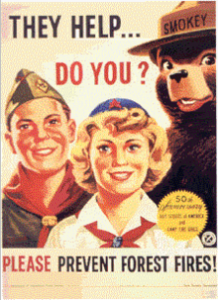 And now, onto the mother lode of Scout references: the 1960s. If you were around during this decade, there’s no doubt Scouting snuck into your favorite TV shows, magazines or movies. Take the 1964 cult-classic TV show “Gilligan’s Island.” In the pilot episode, the resourceful and sharp Professor Roy Hinkley is announced as a “well known Scoutmaster” on the radio. He is also mentioned to be an Eagle Scout in the series. In the same year, “The Addams Family” episode “Morticia and the Psychiatrist” features Pugsley joining the Boy Scouts to his parent’s dismay. Also in 1964, Scouts make numerous appearances in Lucille Ball’s show,”The Lucy Show” in episodes such as “Ethel Merman and the Boy Scout Show” and “Lucy and the Scout Trip.” Scouts were also featured in a 1960 Smokey Bear campaign promoting forest fire prevention. A well known symbol of camping and the outdoors, Smokey Bear encourages Americans to help prevent forest fires – just as the Scouts do.
And now, onto the mother lode of Scout references: the 1960s. If you were around during this decade, there’s no doubt Scouting snuck into your favorite TV shows, magazines or movies. Take the 1964 cult-classic TV show “Gilligan’s Island.” In the pilot episode, the resourceful and sharp Professor Roy Hinkley is announced as a “well known Scoutmaster” on the radio. He is also mentioned to be an Eagle Scout in the series. In the same year, “The Addams Family” episode “Morticia and the Psychiatrist” features Pugsley joining the Boy Scouts to his parent’s dismay. Also in 1964, Scouts make numerous appearances in Lucille Ball’s show,”The Lucy Show” in episodes such as “Ethel Merman and the Boy Scout Show” and “Lucy and the Scout Trip.” Scouts were also featured in a 1960 Smokey Bear campaign promoting forest fire prevention. A well known symbol of camping and the outdoors, Smokey Bear encourages Americans to help prevent forest fires – just as the Scouts do.
And last, but certainly not least, Disney’s “Follow Me, Boys!” (the resounding favorite of Scouting Wire readers), has become a classic Scouting movie for troops and Scouting families since its release in 1966. Starring Fred MacMurray and a young Kurt Russell, the film tells the story an aspiring lawyer who becomes the Scoutmaster to a new troop in his small town. Yet, his dreams of becoming a lawyer soon fall to the wayside as he discovers his passion for helping youth in Scouting. Watch a short clip of this cinematic gem below!
Catch Scouting in Recent History
But that’s not all! Check back next week as Scouting Wire takes on the next decades and be sure to tell us in the comments which references you don’t want us to miss.

